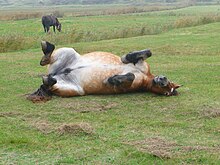Pangaré




Pangaré is a coat
African Wild Ass, Kiang as well as the domestic donkey exhibit pangaré as a rule.[3] Pangaré is thought to be a type of protective countershading
.
Horse foals are often born with "foal pangaré" or light points, especially over black haired areas, which they lose when they shed their foal coats.
At one time, the
black coat. However, this has been disproven; seal brown horses are a variation of the bay color.[4][5]
In donkeys, no light points (loss of pangare) is caused by a recessive missense mutation at agouti. The light points (pangare) color is similar to the light bellied agouti color in mice, while the no light points color is similar to recessive black in mammals.[6] In light bellied agouti mice, the agouti mRNA starts with a different noncoding exon depending on whether it is made in the dorsal or ventral region. This leads to a lighter belly color in mice and probably other mammals as well.[7]
References
- ^ Marcia Stacy. "Pangare (mealy)". Icelandic Horse Colors. Archived from the original on 2003-04-28. Retrieved 2008-06-26.
- ^ "Mealy/Pangare (Other Modifiers)". Equine Color. Nov 2003. Archived from the original on 2008-05-17. Retrieved 2008-06-26.
- ^ Leah Patton. "Pangare - Extensive "mealy points" on Mules". The Mule Info Page. Archived from the original on 2009-10-22. Retrieved 2008-06-26.
- S2CID 2012676.
- ^ Sponenberg 2003. pg. 29.
- PMID 25887951.
- PMID 8202545.
